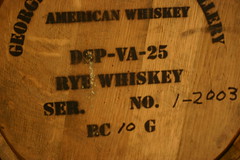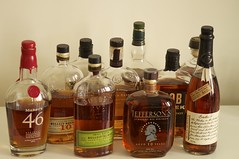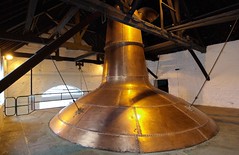
Whiskey
There are so many different styles of whiskey being produced it would be impossible to cover them all in detail here. We’ll try to cover the basic characteristics of whiskey and discuss the most common types that can be found behind the bar today.
How’s it Made?:
- Whiskeys start as a cereal grain (like corn, rye or barley).
- Just like with vodka and other starch-sourced spirits, the starches are cooked to convert into fermentable sugars.
- The mixture is fermented to create what is essentially a low alcohol beer.
- This beer is then distilled.
- Finally, the distilled spirit will be aged in Oak barrels to pick up much of their final flavor profile.

American Whiskey
Three of the most common types of American Whiskey are Bourbon, Rye and Tennessee Whiskeys. Other types include Rye malt whiskey, malt whiskey, wheat whiskey and corn whiskey, and most are differentiated primarily by the ingredients that make up the mash they are made of. For the purposes of this conversation we will discuss Bourbon, Rye and Tennessee Whiskey as an example of the types of flavors that whiskey can bring to a cocktail.
Here are the legal requirements that define each type:
As you can see below, the legal requirements are fairly specific and do not differ much by type.
[table]
Bourbon |
Rye |
Tennessee |
|
| Geographical Limitations: | Must be produced in the USA | None | Must be Produced in Tennessee, USA |
| Made of… | At least 51% Corn | At least 51% Rye | At least 51% Corn |
| Distilled to… | No more than 80% Alcohol by Volume | ||
| Filtered before Aging? | No | Yes, through a Maple Charcoal Filter | |
| % ABV on Entering the Barrel: | Cannot be higher than 62.5% ABV | ||
| Barrels: | Must be aged in charred, new Oak Barrels | ||
| Bottled: | Must be Bottled at no less than 40% ABV | ||
[/table]
American Whiskey in Cocktails:
- All three of these bring a strong barrel influence, due to the fact that the barrels are both new and charred. This contributes up to 70% of the flavor of the whiskey comes from the barrel. Flavors include vanilla, caramel, toffee and baking spices.
- Higher corn content in the whiskey generally results in a sweeter spirit with a richer mouthfeel.
- The higher the rye content, the spicier and drier the final spirit will be, along with other vegetal flavors and slight fruit notes.
- The key difference between Tennessee whiskey and the others mentioned here is that it is filtered before aging. I find this results in a more mellow and less complex spirit with a cleaner taste profile. There can be a hint of smokiness associated with this style of whiskey as well.

Canadian Whisky
There are relatively few legal requirements for how Canadian whisky is made. In general it has a relatively high corn content and is significantly lighter in flavor and color than American whiskeys, resulting in a spirit that can be more approachable to customers who usually shy away from brown spirits.
How it’s Made:
- Canadian Whisky can be distilled up to 90% alcohol, which also strips away much of the flavor.
- It can also be aged in previously used barrels, which results in less barrel flavor being added after distillation.
Canadian Whisky in Cocktails:
Due to all of the reasons mentioned above, Canadian whisky is not a great candidate if you are looking for a spirit to add richness and complexity to a drink. On the other hand, it can be a good “gateway whisky” to help customers bridge the gap into brown spirit cocktails.

Irish Whiskey
Irish Whiskey, like Canadian whiskey, has very few legal requirements to follow.
How it’s Made:
- Irish whiskey can be distilled all the way up to 94.8% ABV, (which, if you recall, is very close to the 97.5% used for creating neutral grain spirits.) When whiskeys are distilled to such a high proof, very little of the flavor from the original mash get into the final product.
- In contrast to Canadian whiskey, however, Irish whiskeys are required to be aged in wood for at least three years.
Irish Whiskey in Cocktails:
While most of the original ingredients’ flavor has been stripped away through the very thorough distillation process, Irish whiskey makes up for some f the flavor loss through requiring quite a bit of time in barrels. The three year minimum gives the spirit quite a bit of time to take on the flavor from the barrel. Still, when using Irish whiskey in cocktails, don’t expect it to have a strong backbone to hold up your drink. It’ll contribute some subtle honeyed and heather notes with slight fruit flavor, but not a lot of assertive character and they are easily overwhelmed by other cocktail ingredients.

Scotch & Japanese Whiskys
Scotch Whisky
Scotch whisky, or “Scotch” for short, is considered the pinnacle of whiskeys worldwide. The most common type is Single Malt, but you may also come across Blended Scotches as well.
How Single Malt Scotch is Made:
- Scotch is made from malted barley which is fermented and distilled through a pot still.
- The barley wine is distilled up to three times until it reaches an alcohol percentage of around 60-70%. Then if needed, it is diluted down to 62.5% before entering barrels for aging.
- It must be aged for three years but is often kept for much longer.
- One interesting fact about scotch whiskys is that they can be aged in used barrels, and often are. Many producers will use barrels used to age wine or other spirits in order to add complexity and flavor to the scotch.
How Blended Scotch is Made:
Blended scotch is a great stepping stone into single malt scotch. It is typically a blend of one or more single malt scotches along with less expensive (and less intense) grain whiskey. This results in a scotch that is more approachable in cost and flavor for your average customer.
Types & Flavors:
[table]
| Lowland Single Malts | Mellow, almost Irish whiskey quality |
| Highlands Single Malts | Known to produce a wide variety of styles. This is a large geographic area, and as a result scotches can be everything from rich and aromatic to dry and fruity. Scotches made closer to the coast will start to have flavors of peat and smoke. |
| Speyside Single Malts | Speyside is a small region within the larger Highland area that’s known to produce a rich and sweet single malt. It is aromatic with hints of honey, toffee, heather and citrus. This is a great introductory single malt scotch and tends to be a crowd pleaser. |
| Islay Scotch | Islay is the most powerful of the five main single malt scotches. It is characterized by smoke, salty sea air, peat, iodine and hints of heather. Bartenders will sometimes use Islay scotch to rinse a glass before making a cocktail and that is enough to contribute its character to a cocktail. |
| Campbeltown Scotch | This scotch is best described as a cross between highland single malts and Islay. |
[/table]
Japanese Whiskey
Japanese whiskey is relatively new to the scene, only starting to commercially produce whisky in the early 1900’s. As a genre, Japanese whiskey is very similar to Scotch, and has in recent years even begun to win international Scotch competitions. The variety of Japanese whiskys available is immense, and crosses single malt and blended varieties.
Japanese & Scotch Whisky in Cocktails:
Since Scotch is both complex and expensive, it is generally not utilized very often in cocktails. Islay scotch is the one exception – since its flavor is so powerful, a very small amount can impart flavor into a drink, making it cost effective. In my experience, scotches are generally reserved for enjoyment neat or on the rocks.

